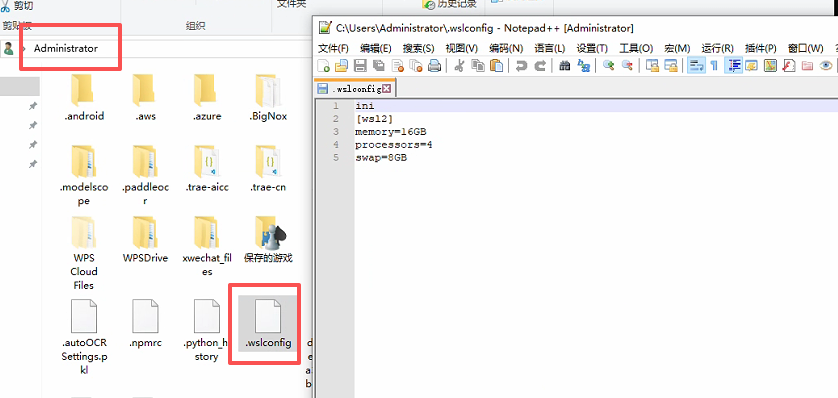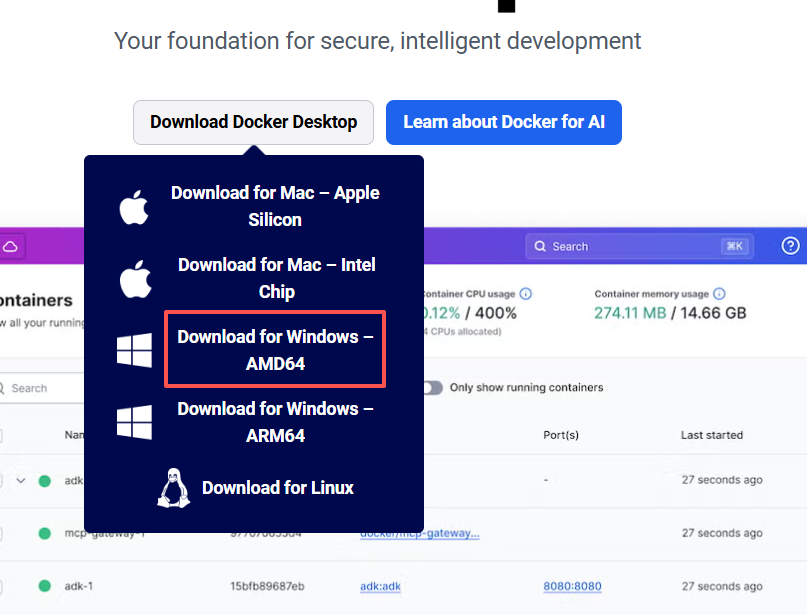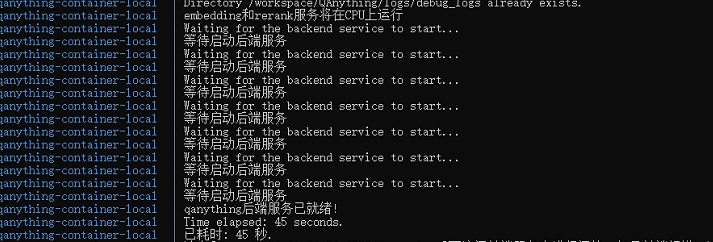在windows 的子系统Ubuntu部署qanything-v2
QAnything
开发者:网易有道
核心特点:
支持多种文件格式,包括PDF、Word、PPT、Excel、图片等
采用两阶段检索架构(Embedding + Rerank),解决大规模数据检索准确率问题
支持纯本地部署,保障数据安全
跨语种问答能力,中英文混合问答
支持 高性能,数据量越大效果越好
部署方式:Docker Compose一键部署,支持Windows(WSL2)、Linux和macOS
技术架构:基于自研RAG引擎,集成BCEmbedding和Reranker模型
0. 默认已开启Hyper-V、适用于Linux的Windows子系统 、虚拟机平台;
安装了ubuntu;
升级了WSL2;
1. 设置WSL内存

1.1 配置WSL2
在文件路径中输入%USERPROFILE%,并创建.wslconfig
文件内容:
ini
[wsl2]
memory=16GB # 增加到 16GB
processors=4
swap=8GB # 增加到 8GB
关闭 wsl --shutdown 服务
2. 在Ubuntu上拉取 QAnything项目
在ubuntu安装unzip;
sudo apt update 更新包管理器索引
sudo apt install unzip
cd /home
sudo wget https://github.com/netease-youdao/QAnything/archive/refs/heads/qanything-v2.zip # 解压 sudo unzip qanything-v2.zip # 重命名 sudo mv QAnything-qanything-v2/ qanything sudo chmod -R 777 /home/qanything
3. 安装docker
参考 https://blog.csdn.net/sgx1825192/article/details/146965328
选择在Windows电脑上安装Docker Desktop on Windows
下载链接https://www.docker.com/

一般是选择 Download for Windows AMD64;可以查看自己电脑的处理器信息,
1. 按 Win + X,然后选择 设备管理器。 2. 展开 处理器 部分,查看显示的处理器型号。 3. 如果显示的是 Intel 或 AMD,通常就是 AMD64 版本; 4. 如果是 ARM 处理器(如 Qualcomm Snapdragon 或 Apple M1/M2),则是 ARM64。 如果你的电脑是使用 Intel 或 AMD 的 64 位处理器,选择 Download for Windows AMD64。
docker 命令
查看所有容器:docker ps -a 停止所有正在运行的容器:docker stop $(docker ps -q) 删除所有容器(停止并移除):docker rm $(docker ps -aq) 强制停止并删除所有容器:docker rm -f $(docker ps -aq) 停止容器 docker stop <container_id_or_name> 删除容器 docker rm <container_id_or_name> 强制删除运行中的容器 docker rm -f <container_id_or_name> # 检查磁盘空间 df -h # 清理 Docker 资源 sudo docker system prune -a # 清除所有未使用的镜像和构建缓存 sudo docker system prune -a --volumes
测试docker拉取镜像
sudo docker pull hello-world
如果报 failed to unpack image on snapshotter overlayfs: unexpected media type text/html for sha256:ef190a734c6ddb9dc29de0770bcc321a0b1eef445cd1d5368385ef650cc03024: not found;此报错为镜像源的问题, 在网上查一些新的可用的镜像源
在docker设置中添加新的
"registry-mirrors": [
"https://registry.cyou",
"https://docker-0.unsee.tech",
"https://hub.rat.dev",
"https://docker.m.daocloud.io",
"https://f1361db2.m.daocloud.io",
"https://docker.xuanyuan.me"
]
通过 sudo curl -I https://docker.m.daocloud.io测试链接是否可用。registry-mirrors中只保留可用的链接。
4. 修改配置文件 /home/qanything/qanything_kernel/configs/model_config.py 和 /home/qanything/docker-compose-linux.yaml
import os
from dotenv import load_dotenvload_dotenv()
# 获取环境变量GATEWAY_IP
GATEWAY_IP = os.getenv("GATEWAY_IP", "localhost")
# LOG_FORMAT = "%(levelname) -5s %(asctime)s" "-1d: %(message)s"
# logger = logging.getLogger()
# logger.setLevel(logging.INFO)
# logging.basicConfig(format=LOG_FORMAT)
# 获取项目根目录
# 获取当前脚本的绝对路径
current_script_path = os.path.abspath(__file__)
root_path = os.path.dirname(os.path.dirname(os.path.dirname(current_script_path)))
UPLOAD_ROOT_PATH = os.path.join(root_path, "QANY_DB", "content")
IMAGES_ROOT_PATH = os.path.join(root_path, "qanything_kernel/qanything_server/dist/qanything/assets", "file_images")
print("UPLOAD_ROOT_PATH:", UPLOAD_ROOT_PATH)
print("IMAGES_ROOT_PATH:", IMAGES_ROOT_PATH)
OCR_MODEL_PATH = os.path.join(root_path, "qanything_kernel", "dependent_server", "ocr_server", "ocr_models")
RERANK_MODEL_PATH = os.path.join(root_path, "qanything_kernel", "dependent_server", "rerank_server", "rerank_models")
EMBED_MODEL_PATH = os.path.join(root_path, "qanything_kernel", "dependent_server", "embed_server", "embed_models")
PDF_MODEL_PATH = os.path.join(root_path, "qanything_kernel/dependent_server/pdf_parser_server/pdf_to_markdown")# LLM streaming reponse
STREAMING = TrueSYSTEM = """
You are always a reliable assistant that can answer questions with the help of external documents.
You are an AI assistant that follows instructions extremely well. Help as much as you can.
Your answer needs to be accurate, well-structured, and focused on key points.
The answer should have sources from the reference document. Do not hallucinate, do not make up factual information.
Your tone should be professional and helpful.
Today's date is {{today_date}}. The current time is {{current_time}}.### Global Answering Rules:
1. **Strict content matching**: - Your responses should always be based on the reference information provided. - Do not speculate or invent information that is not present in the documents.
2. **Answer format**:- Provide well-structured answers, using headings, bullet points, or tables when appropriate.
3. **No redundancy**:- If different parts of the reference contain overlapping information, merge and summarize them to avoid repetition.
4. **Flexible use of information sources**:- During the **inference and reasoning process**, use the "Information Sources" module to track document citations and ensure accuracy.- **Each reference** must be listed separately with its corresponding information (ref_number, title, section, abstract). - **Do not include the full "Information Sources" section in the final user-facing answer**.
5. **Start the "Inferred Answer" Section**: - Directly start the user-facing response with "According to the reference information".- Ensure that the answer is natural, professional, logically coherent, and directly relevant to the question.
6. **Post-answer check**:- Ensure all parts of the question are addressed, citations are accurate, and the response is logically consistent.
7. **Language and Format**:- The response should be in the same language as the question.- Use Markdown format for headings (##, ###, ####), bullet points (- or 1., 2., 3.), and tables for clarity.
"""INSTRUCTIONS = """
- Task: Answer the question "{{question}}" strictly based on the reference information provided between <DOCUMENTS> and </DOCUMENTS>, following the steps and format outlined below.---### Answering Steps:
1. **Use of Information Sources** (Internal step):- During the inference process, use the "Information Sources" section to gather and organize the relevant document citations.- **Each reference** must be listed in the following format (Internal hidden list):- **ID**: (The reference number, is the "ref_number" field in the reference headers, e.g., [REF.1])- **Title**: (The filename or title, is the "文件名" field in the reference headers. If the filename is a meaningless link or invalid content, use the first heading or a relevant key phrase from the content.)- **Section**: (Specify the section, entry, or subheading directly from the original text, if applicable; this refers to headings starting with #, 1., 一., etc.)- **Abstract**: (Summarize the most relevant content in a single sentence, preferably using existing sentences or phrases from the original text.)- **Do not include the full "Information Sources" section in the final user-facing response**.
2. **Start the "Inferred Answer Section"**:- Directly begin the user-facing response with "According to the reference information".- **Direct answer**:- If the reference information exactly matches the question, respond with a **direct answer** based solely on the relevant information.- **Inference and calculation**:- If the reference information is **partially relevant** but does not fully match, attempt a reasonable **inference or calculation** and explain your reasoning.- Ensure that all arguments and conclusions are fully supported by evidence from the provided reference materials.- Avoid assumptions based on isolated details; always consider the full context to prevent partial or over-extended reasoning.- **Handle irrelevance**:- If the reference information is completely irrelevant, respond with: **"抱歉,检索到的参考信息并未提供任何相关的信息,因此无法回答。"**- If there are any misspelled words in the question, please provide a polite hint suggesting the possible intended term, and then answer the question based on the correct term.
---### Pre-Answer Confirmation:
1. Ensure all key points from the reference information are addressed.
2. Avoid redundancy by merging and summarizing overlapping information.
3. Ensure there are no contradictions or inconsistencies in the response.---### Post-Answer Checklist:
1. **Answer completeness**: Ensure all parts of the question have been addressed.
2. **Logic & consistency**: Double-check for any logical errors or internal contradictions in the response.
3. **Citation accuracy**: Ensure the relevance, completeness, and accuracy of the information source, as well as the consistency of the format.---### Language and Format:
- Respond in the same language as the question "{{question}}", using "根据参考信息" if in Chinese, or "According to the reference information" if in English.
- **Flexible Format**:- Use headings (##, ###, ####), bullet points, or tables as appropriate.- Use **bullet points** (- or 1., 2., 3.) for listing multiple points.- **Highlight key information** using **bold** or *italic* text where relevant.- **Reference ID visibility**:- Do not show reference IDs in the final answer.- For list or comparison-based questions, use **tables** or **bullet points**.- For narrative-style answers, use **paragraphs** to clearly explain the details.
"""PROMPT_TEMPLATE = """
<SYSTEM>
{{system}}
</SYSTEM><INSTRUCTIONS>
{{instructions}}
</INSTRUCTIONS><DOCUMENTS>
{{context}}
</DOCUMENTS><INSTRUCTIONS>
{{instructions}}
</INSTRUCTIONS>
"""CUSTOM_PROMPT_TEMPLATE = """
<USER_INSTRUCTIONS>
{{custom_prompt}}
</USER_INSTRUCTIONS><DOCUMENTS>
{{context}}
</DOCUMENTS><INSTRUCTIONS>
- All contents between <DOCUMENTS> and </DOCUMENTS> are reference information retrieved from an external knowledge base.
- Now, answer the following question based on the above retrieved documents(Let's think step by step):
{{question}}
</INSTRUCTIONS>
"""SIMPLE_PROMPT_TEMPLATE = """
- You are a helpful assistant. You can help me by answering my questions. You can also ask me questions.
- Today's date is {{today}}. The current time is {{now}}.
- User's custom instructions: {{custom_prompt}}
- Before answering, confirm the number of key points or pieces of information required, ensuring nothing is overlooked.
- Now, answer the following question:
{{question}}
Return your answer in Markdown formatting, and in the same language as the question "{{question}}".
"""# 缓存知识库数量
CACHED_VS_NUM = 100# 文本分句长度
SENTENCE_SIZE = 100# 知识库检索时返回的匹配内容条数
VECTOR_SEARCH_TOP_K = 30VECTOR_SEARCH_SCORE_THRESHOLD = 0.3KB_SUFFIX = '_240625'
# MILVUS_HOST_LOCAL = 'milvus-standalone-local'
# MILVUS_PORT = 19530
MILVUS_HOST_LOCAL = "milvus" #修改 使用容器服务名 旧GATEWAY_IP
MILVUS_PORT = 19530 #修改 改成容器内部端口
MILVUS_COLLECTION_NAME = 'qanything_collection' + KB_SUFFIX# ES_URL = 'http://es-container-local:9200/'
ES_URL = "http://elasticsearch:9200/" #修改 使用容器服务名 # f'http://{GATEWAY_IP}:9210/'
ES_USER = None
ES_PASSWORD = None
ES_TOP_K = 30
ES_INDEX_NAME = 'qanything_es_index' + KB_SUFFIX# MYSQL_HOST_LOCAL = 'mysql-container-local'
# MYSQL_PORT_LOCAL = 3306
MYSQL_HOST_LOCAL = "mysql" #修改 使用容器服务名
MYSQL_PORT_LOCAL = 3306 #修改 改成容器内部端口
MYSQL_USER_LOCAL = 'root'
MYSQL_PASSWORD_LOCAL = '123456'
MYSQL_DATABASE_LOCAL = 'qanything'LOCAL_OCR_SERVICE_URL = "localhost:7001"LOCAL_PDF_PARSER_SERVICE_URL = "localhost:9009"LOCAL_RERANK_SERVICE_URL = "localhost:8001"
LOCAL_RERANK_MODEL_NAME = 'rerank'
LOCAL_RERANK_MAX_LENGTH = 512
LOCAL_RERANK_BATCH = 1
LOCAL_RERANK_THREADS = 1
LOCAL_RERANK_PATH = os.path.join(root_path, 'qanything_kernel/dependent_server/rerank_server', 'rerank_model_configs_v0.0.1')
LOCAL_RERANK_MODEL_PATH = os.path.join(LOCAL_RERANK_PATH, "rerank.onnx")LOCAL_EMBED_SERVICE_URL = "localhost:9001"
LOCAL_EMBED_MODEL_NAME = 'embed'
LOCAL_EMBED_MAX_LENGTH = 512
LOCAL_EMBED_BATCH = 1
LOCAL_EMBED_THREADS = 1
LOCAL_EMBED_PATH = os.path.join(root_path, 'qanything_kernel/dependent_server/embedding_server', 'embedding_model_configs_v0.0.1')
LOCAL_EMBED_MODEL_PATH = os.path.join(LOCAL_EMBED_PATH, "embed.onnx")TOKENIZER_PATH = os.path.join(root_path, 'qanything_kernel/connector/llm/tokenizer_files')DEFAULT_CHILD_CHUNK_SIZE = 400
DEFAULT_PARENT_CHUNK_SIZE = 800
SEPARATORS = ["\n\n", "\n", "。", ",", ",", ".", ""]
MAX_CHARS = 1000000 # 单个文件最大字符数,超过此字符数将上传失败,改大可能会导致解析超时# llm_config = {
# # 回答的最大token数,一般来说对于国内模型一个中文不到1个token,国外模型一个中文1.5-2个token
# "max_token": 512,
# # 附带的上下文数目
# "history_len": 2,
# # 总共的token数,如果遇到电脑显存不够的情况可以将此数字改小,如果低于3000仍然无法使用,就更换模型
# "token_window": 4096,
# # 如果报错显示top_p值必须在0到1,可以在这里修改
# "top_p": 1.0
# }# Bot
BOT_DESC = "一个简单的问答机器人"
BOT_IMAGE = ""
BOT_PROMPT = """
- 你是一个耐心、友好、专业的机器人,能够回答用户的各种问题。
- 根据知识库内的检索结果,以清晰简洁的表达方式回答问题。
- 不要编造答案,如果答案不在经核实的资料中或无法从经核实的资料中得出,请回答“我无法回答您的问题。”(或者您可以修改为:如果给定的检索结果无法回答问题,可以利用你的知识尽可能回答用户的问题。)
"""
BOT_WELCOME = "您好,我是您的专属机器人,请问有什么可以帮您呢?"
services:elasticsearch:networks:- qanything-net # 添加这行container_name: elasticsearch #修改 es-container-localimage: docker.elastic.co/elasticsearch/elasticsearch:8.13.2user: rootprivileged: trueports:- "9210:9200" # Windows/WSL 用 localhost:9210 访问restart: on-failureenvironment:- discovery.type=single-node- xpack.security.enabled=false- "ES_JAVA_OPTS=-Xms1024m -Xmx1024m"volumes:- ${DOCKER_VOLUME_DIRECTORY:-.}/third_party/es/plugins:/usr/share/elasticsearch/plugins- ${DOCKER_VOLUME_DIRECTORY:-.}/volumes/es/data:/usr/share/elasticsearch/datacommand: >/bin/bash -c "mkdir -p /usr/share/elasticsearch/data /usr/share/elasticsearch/plugins &&chown -R elasticsearch:elasticsearch /usr/share/elasticsearch &&su elasticsearch -c '/usr/share/elasticsearch/bin/elasticsearch'"healthcheck:test: curl --fail http://localhost:9200/_cat/health || exit 1interval: 10stimeout: 20sretries: 3start_period: 30s # 添加启动延迟etcd:networks:- qanything-net # 添加这行container_name: milvus-etcd-localimage: quay.io/coreos/etcd:v3.5.5environment:- ETCD_AUTO_COMPACTION_MODE=revision- ETCD_AUTO_COMPACTION_RETENTION=1000- ETCD_QUOTA_BACKEND_BYTES=4294967296- ETCD_SNAPSHOT_COUNT=50000volumes:- ${DOCKER_VOLUME_DIRECTORY:-.}/volumes/etcd:/etcdcommand: etcd -advertise-client-urls=http://127.0.0.1:2379 -listen-client-urls http://0.0.0.0:2379 --data-dir /etcdhealthcheck:test: ["CMD", "etcdctl", "endpoint", "health"]interval: 10stimeout: 20sretries: 3minio:networks:- qanything-net # 添加这行container_name: milvus-minio-localimage: minio/minio:RELEASE.2023-03-20T20-16-18Zenvironment:MINIO_ACCESS_KEY: minioadminMINIO_SECRET_KEY: minioadmin# ports:# - "9001:9001"# - "9000:9000"volumes:- ${DOCKER_VOLUME_DIRECTORY:-.}/volumes/minio:/minio_datacommand: minio server /minio_data --console-address ":9001"healthcheck:test: ["CMD", "curl", "-f", "http://localhost:9000/minio/health/live"]interval: 10stimeout: 20sretries: 3milvus: # 修改,原名为standalonenetworks:- qanything-net # 添加这行container_name: milvus # milvus-standalone-localimage: milvusdb/milvus:v2.4.8logging:driver: "json-file"options:max-size: "100m"max-file: "3"command: ["milvus", "run", "standalone"]security_opt:- seccomp:unconfinedenvironment:ETCD_ENDPOINTS: etcd:2379MINIO_ADDRESS: minio:9000volumes:- ${DOCKER_VOLUME_DIRECTORY:-.}/volumes/milvus:/var/lib/milvushealthcheck:test: ["CMD", "curl", "-f", "http://localhost:9091/healthz"]interval: 10sstart_period: 120stimeout: 20sretries: 5ports:- "19540:19530" # 修改 Windows/WSL 用 localhost:19540 访问depends_on:- "etcd"- "minio"deploy: # 修改 添加资源限制resources:limits:memory: 4Gmysql:networks:- qanything-net # 添加这行container_name: mysql # mysql-container-localprivileged: trueimage: mysql:8.4ports:- "3316:3306" # Windows/WSL 用 localhost:3316 访问command: --max-connections=10000environment:- MYSQL_ROOT_PASSWORD=123456- MYSQL_DATABASE=qanythingvolumes:- ${DOCKER_VOLUME_DIRECTORY:-.}/volumes/mysql:/var/lib/mysqlhealthcheck:test: ["CMD", "mysqladmin", "ping", "-u", "root", "-p123456"]interval: 5stimeout: 3sretries: 10start_period: 30sqanything_local:container_name: qanything-container-localimage: xixihahaliu01/qanything-linux:v1.5.1command: /bin/bash -c "sleep 150 && cd /workspace/QAnything && bash scripts/entrypoint.sh"privileged: trueshm_size: '8gb'volumes:- ${DOCKER_VOLUME_DIRECTORY:-.}/:/workspace/QAnything/# 修改ports:- "8777:8777" # Windows/WSL 浏览器可直接访问 http://localhost:8777# network_mode: "host"networks:- qanything-nethealthcheck:test: ["CMD", "curl", "-f", "http://localhost:8777/health"]interval: 30stimeout: 10sretries: 5environment:- NCCL_LAUNCH_MODE=PARALLEL- GPUID=${GPUID:-0}- USER_IP=${USER_IP:-0.0.0.0}- Gateway_IP=${Gateway_IP:-0.0.0.0}depends_on:milvus: # 修改名字condition: service_healthymysql:condition: service_healthyelasticsearch:condition: service_healthytty: truestdin_open: true# 修改deploy:resources:limits:memory: 8Greservations:memory: 4G# 修改
networks:qanything-net:driver: bridge# networks:
# default:
# name: QAnything5. 分步启动服务
up -d : up 表示启动,-d 表示在后台运行
查看服务名称 docker compose -f docker-compose-linux.yaml config --services
# 先启动基础服务
docker compose -f docker-compose-linux.yaml up -d etcd minio mysql elasticsearch milvus
# 查看服务状态 必须都为(healthy)状态
docker compose -f docker-compose-linux.yaml ps | grep -E "etcd|minio|mysql|elasticsearch|milvus"

查看MySQL运行状态(显示/usr/sbin/mysqld: ready for connections.就是正确的) docker compose -f docker-compose-linux.yaml logs mysql | grep -A 20 "mysqld:"# 检查 MySQL 是否接受连接 docker exec mysql mysqladmin ping -u root -p123456sleep 180 # 最后启动 QAnything docker compose -f docker-compose-linux.yaml up -d qanything_local # 查看 QAnything 实时日志, ctrl+c 退出 docker compose -f docker-compose-linux.yaml logs -f qanything_local

这个状态就是启动成功 在windows浏览器访问 http://127.0.0.1:8777/qanything
其他命令
停止 QAnything 服务 docker compose -f docker-compose-linux.yaml down qanything_local 重新启动服务 docker compose -f docker-compose-linux.yaml up -d qanything_local
docker 安装curl和 netstat docker exec qanything-container-local bash -c "apt update && apt install -y curl" docker exec qanything-container-local apt update docker exec qanything-container-local apt install -y net-tools
使用 xclip 或 xsel 命令将文件内容复制到剪贴板。 sudo apt install xclip xclip -sel clip < xx.txt
查看IP地址:ip addr show eth0 | grep inet # 或者使用hostname命令: hostname -I
如果docker compose -f docker-compose-linux.yaml logs -f qanything_local 显示连接报错,
重新运行服务 1. 先停止所有服务 docker compose -f docker-compose-linux.yaml down -v --remove-orphans 2. 清理 Docker 资源 docker system prune -f 2.1 强制删除问题网络 docker network rm qanything-network || true 3. docker compose -f docker-compose-linux.yaml up -d etcd minio mysql elasticsearch milvus 4. sleep 180 # 最后启动 QAnything docker compose -f docker-compose-linux.yaml up -d qanything_local
